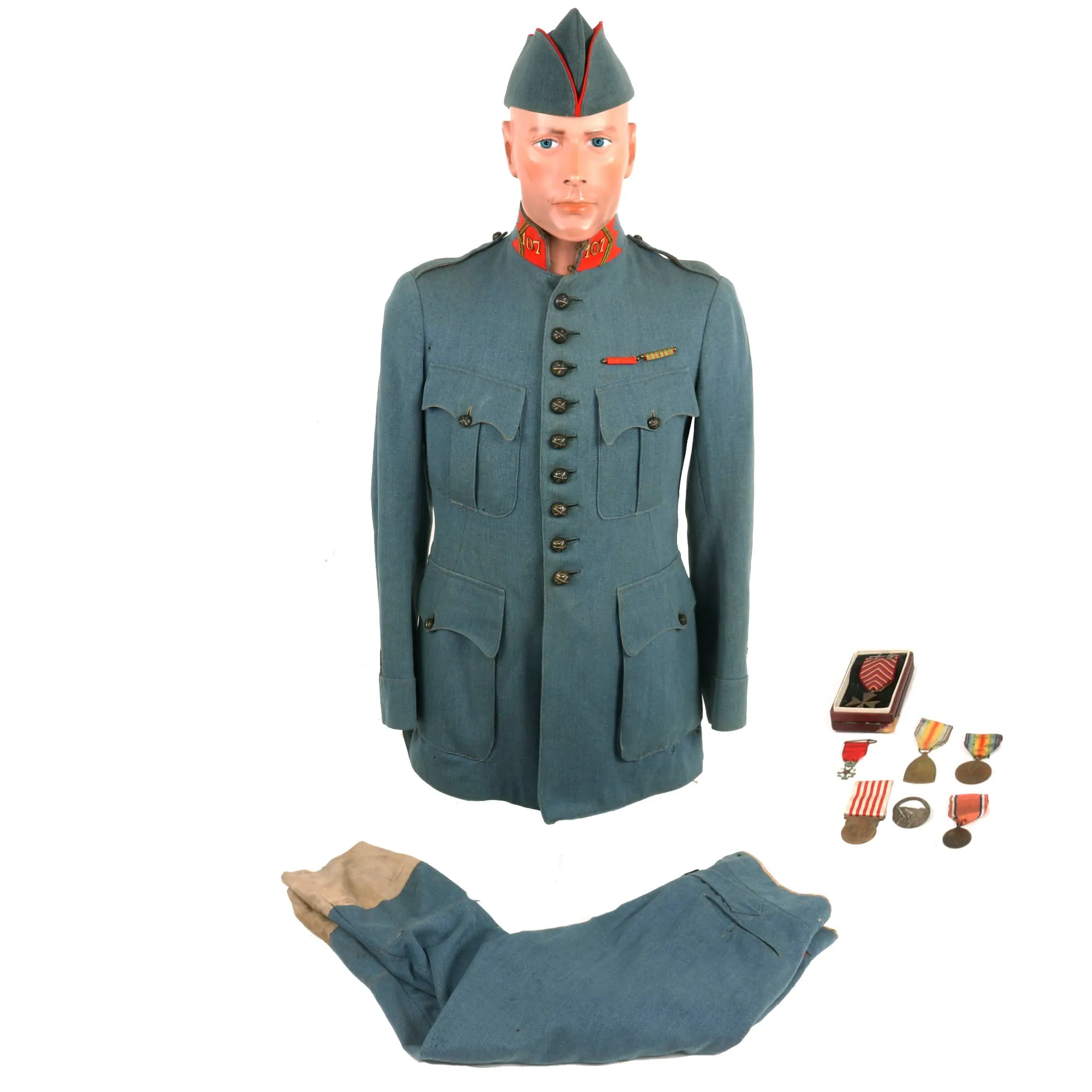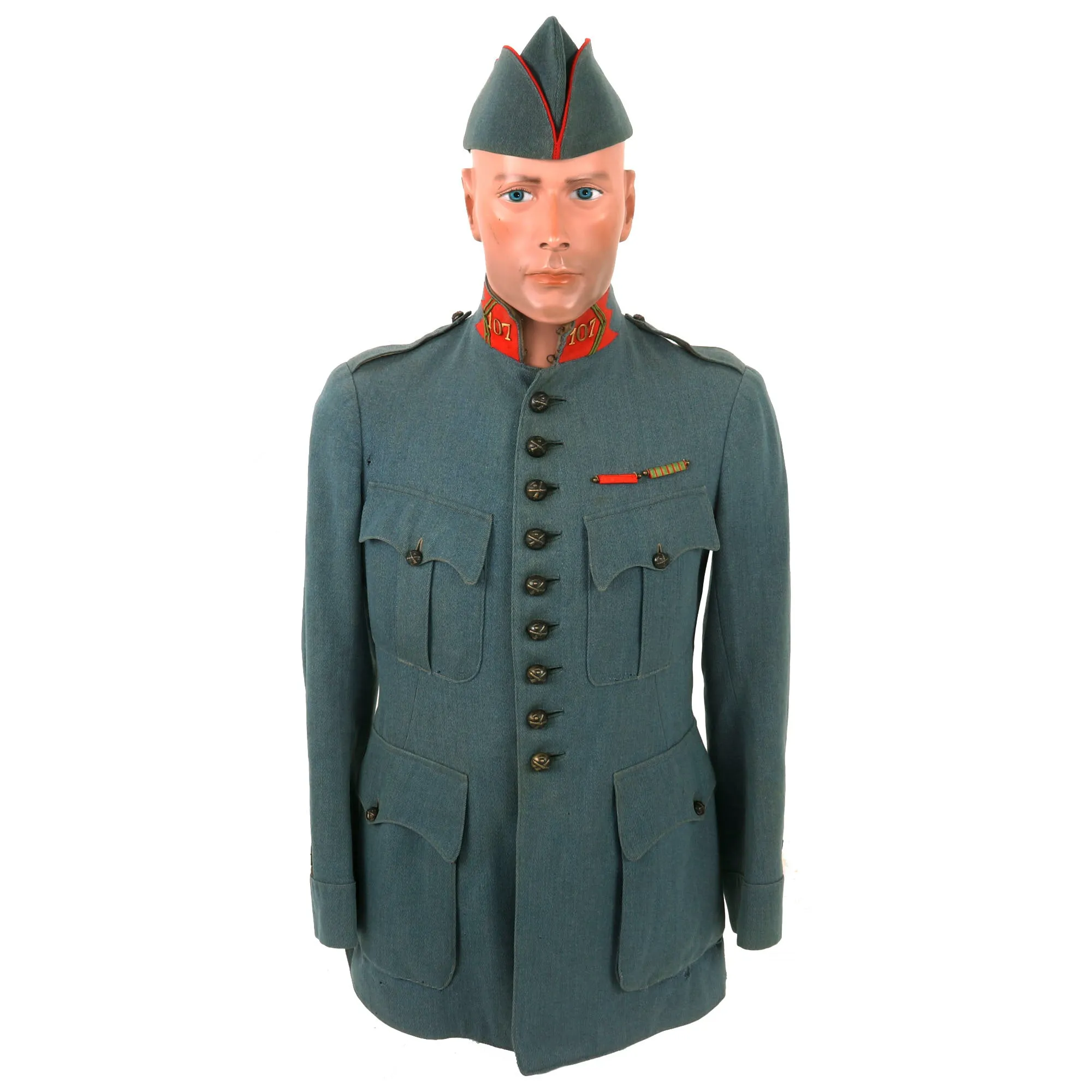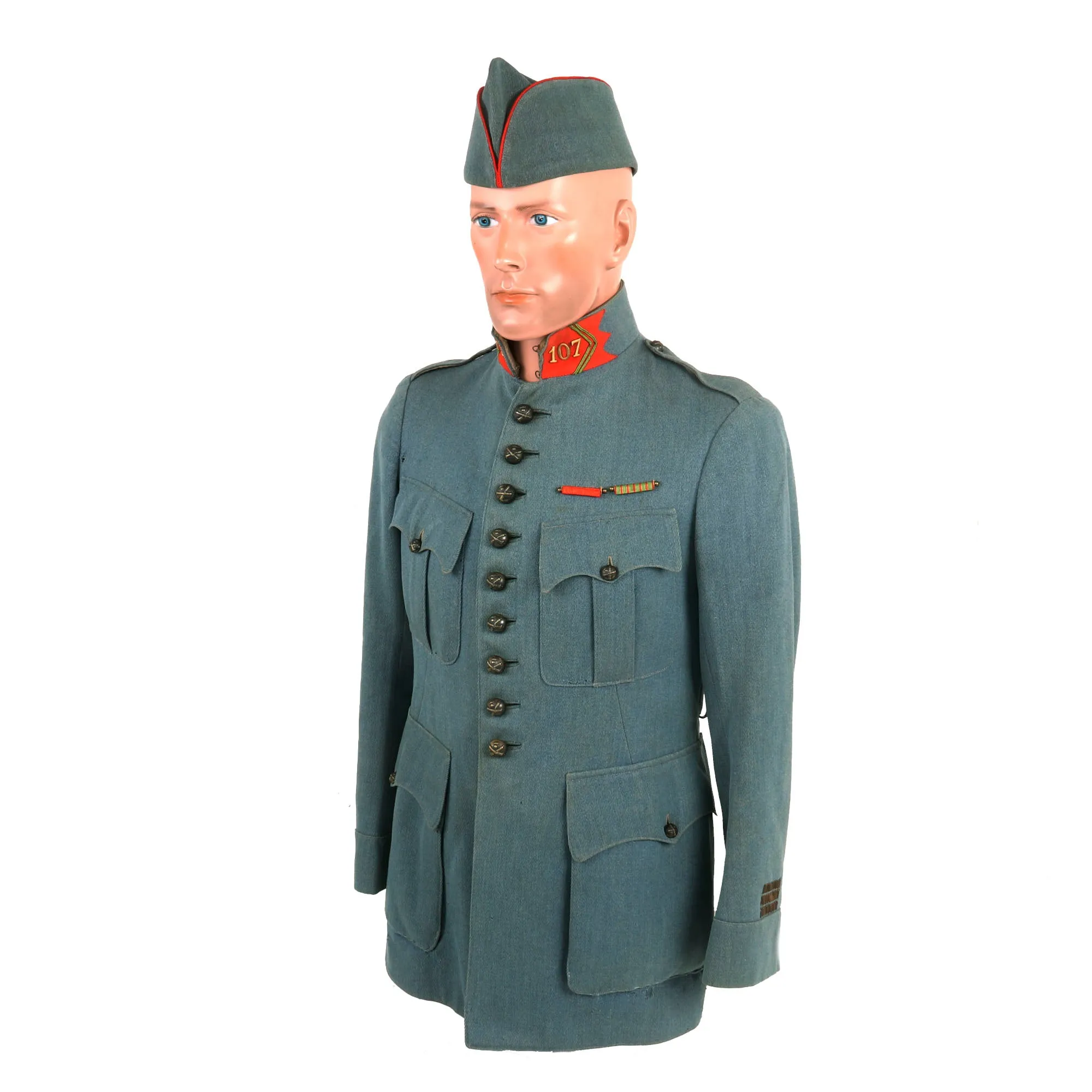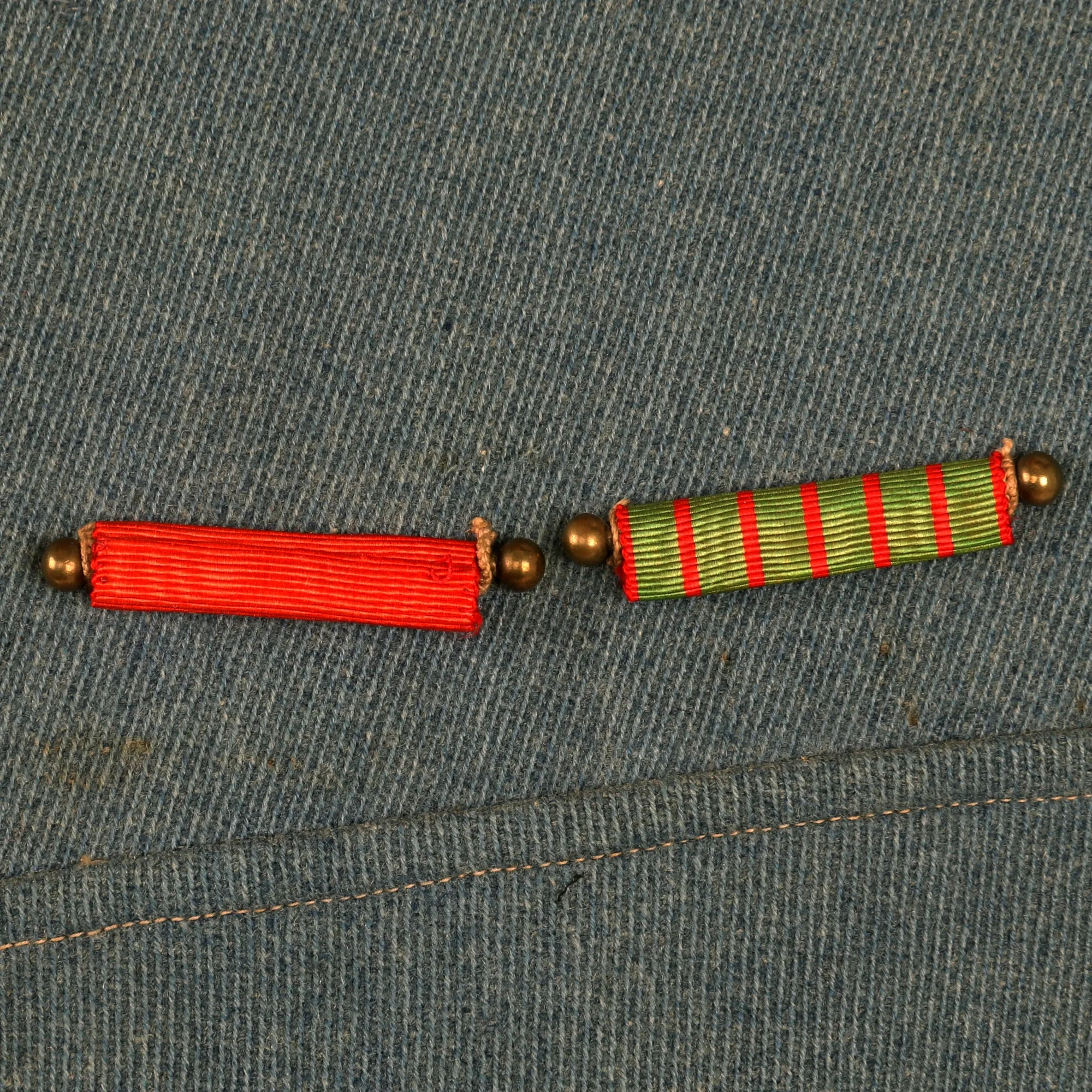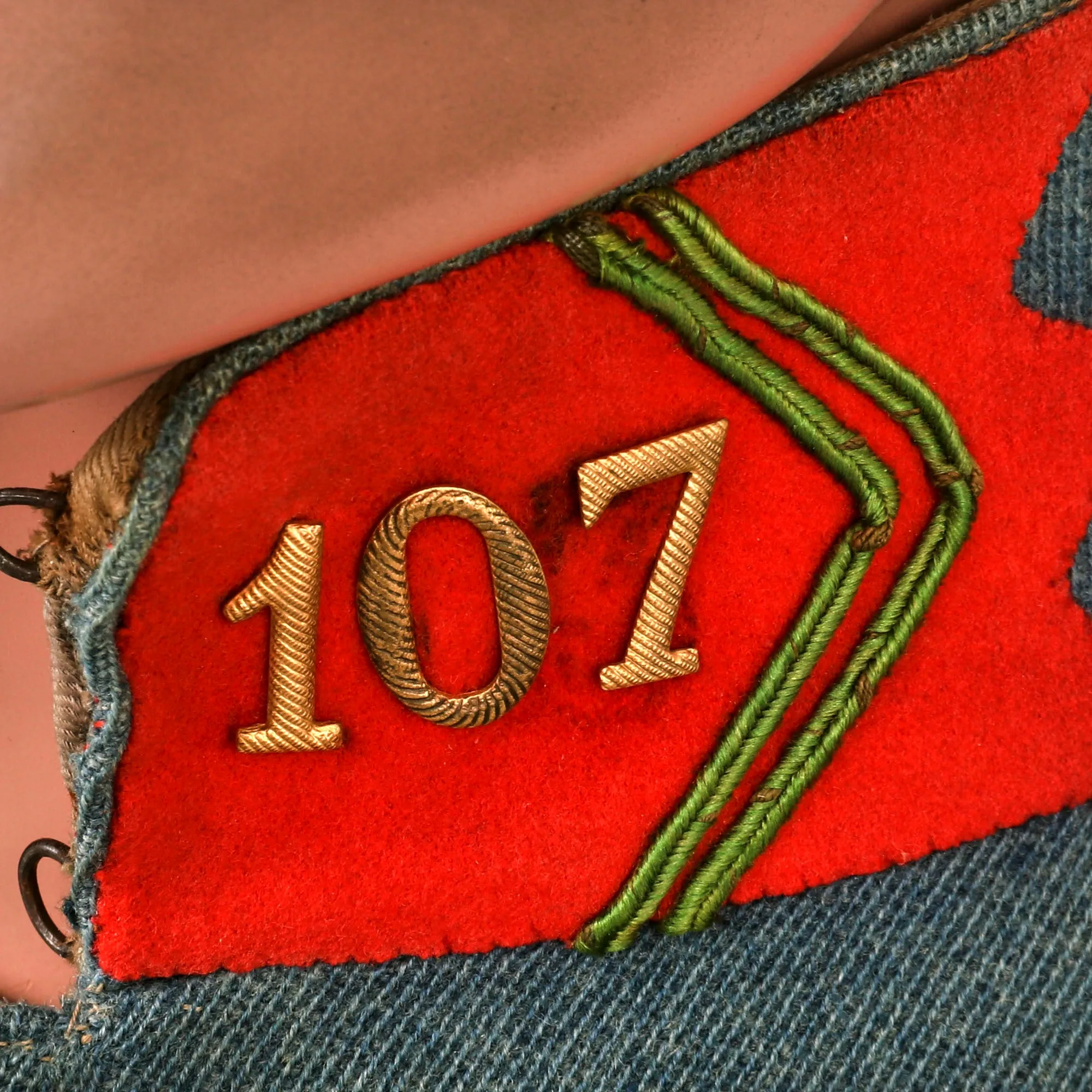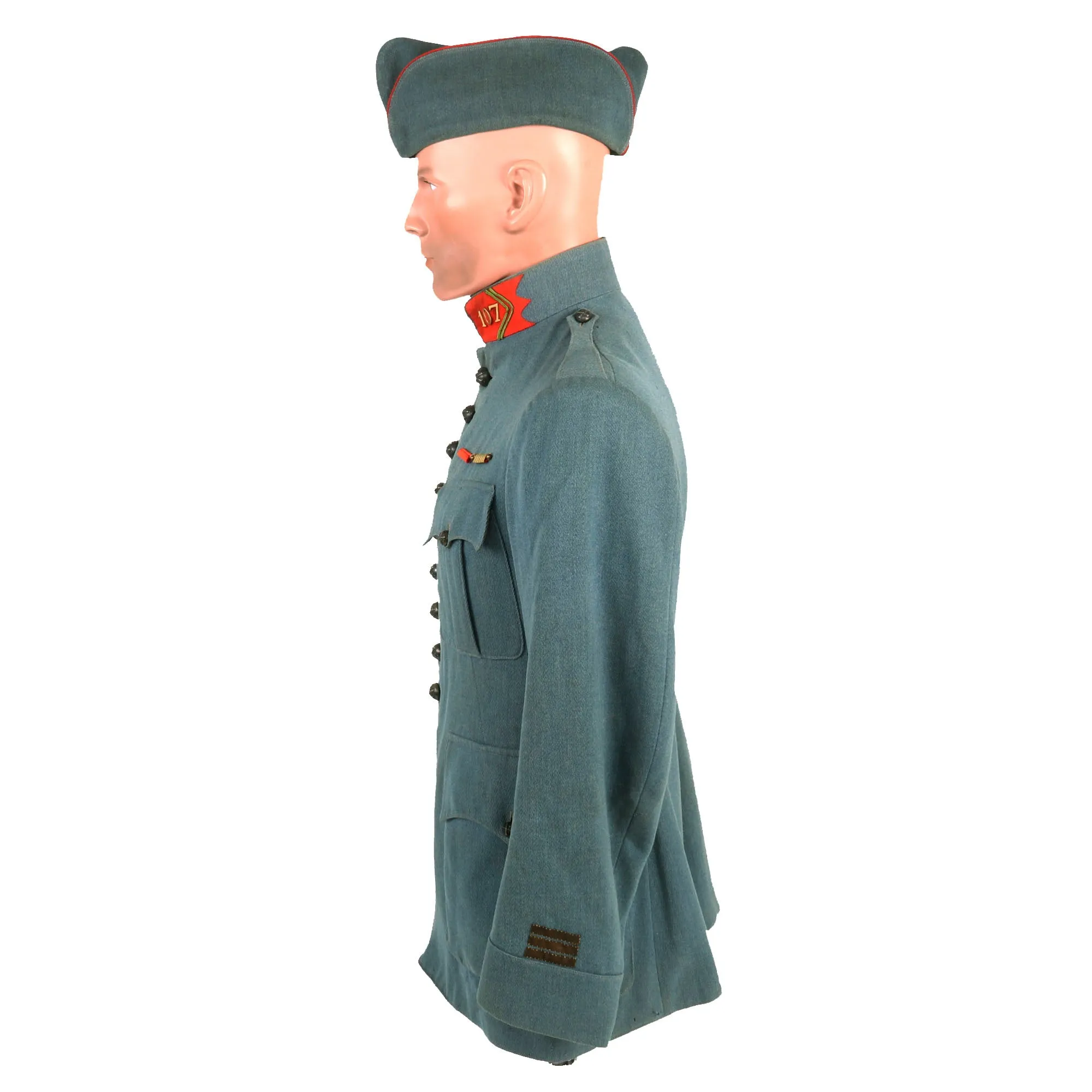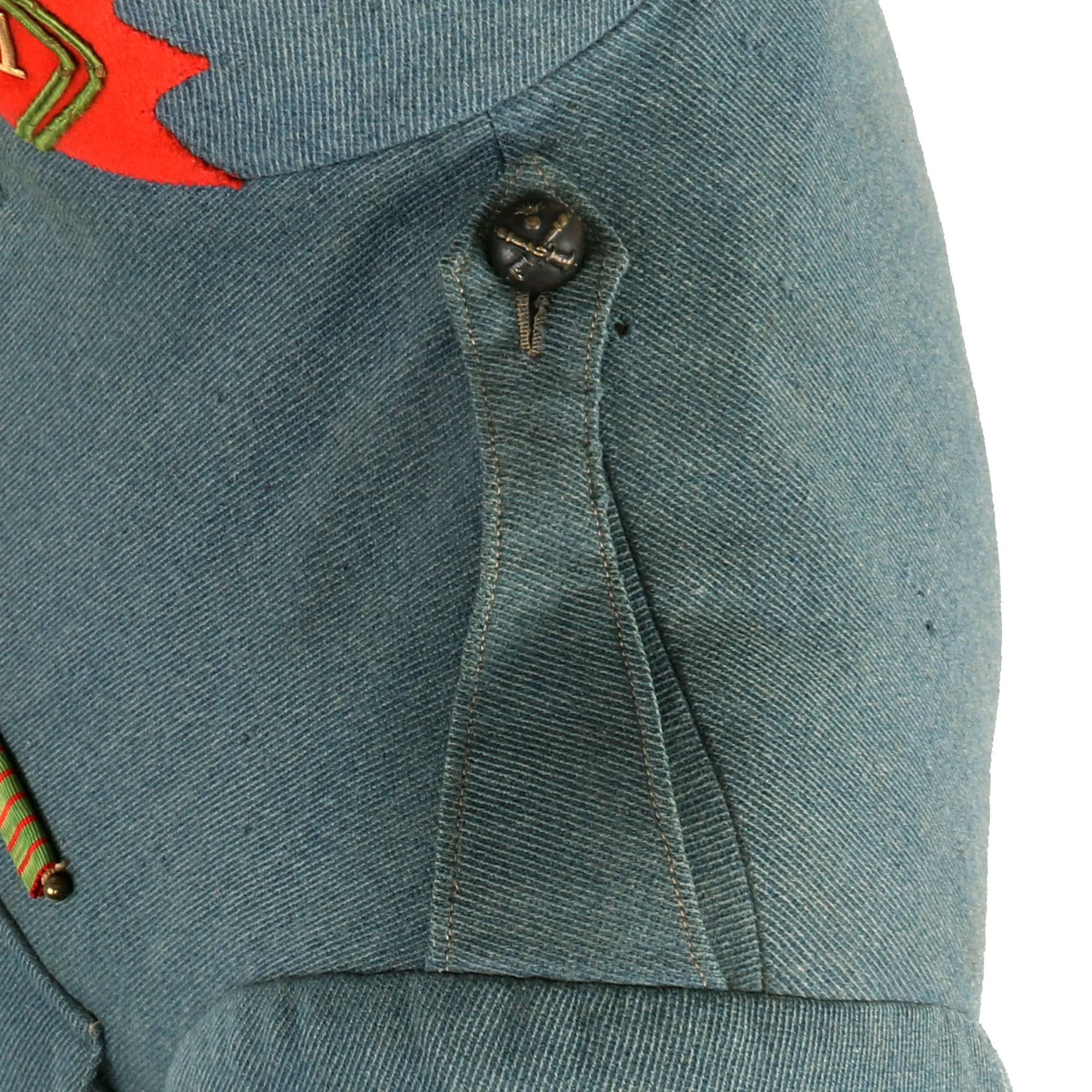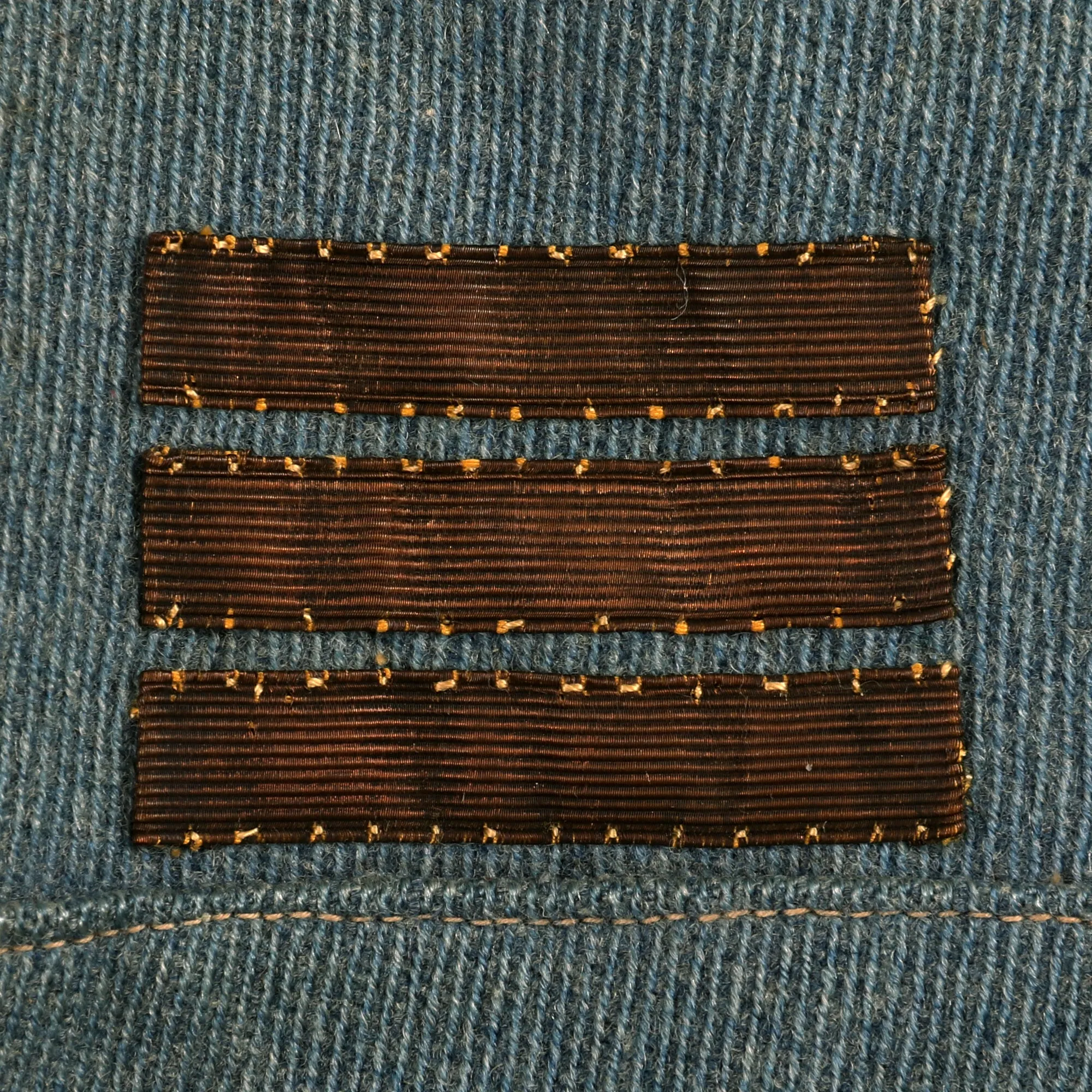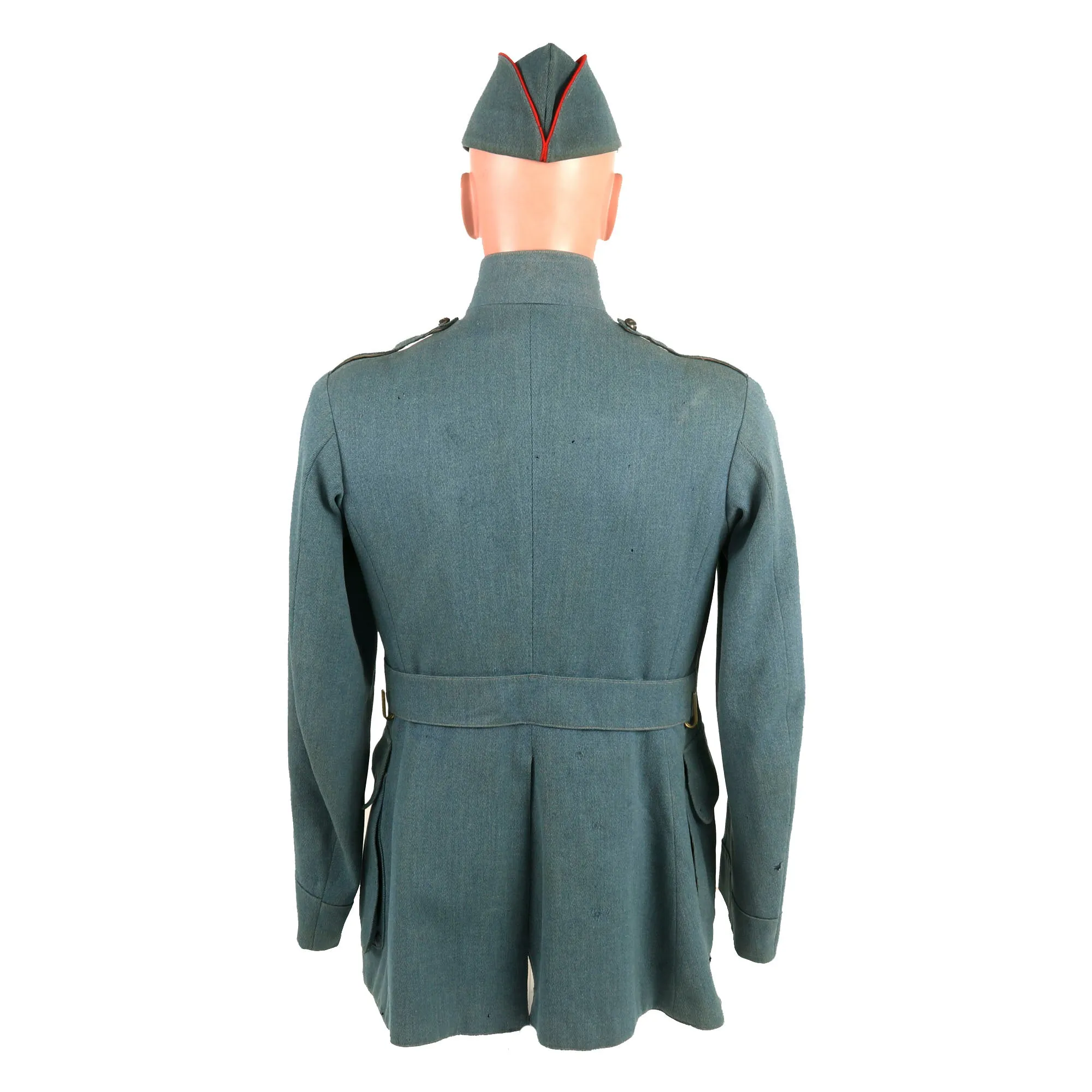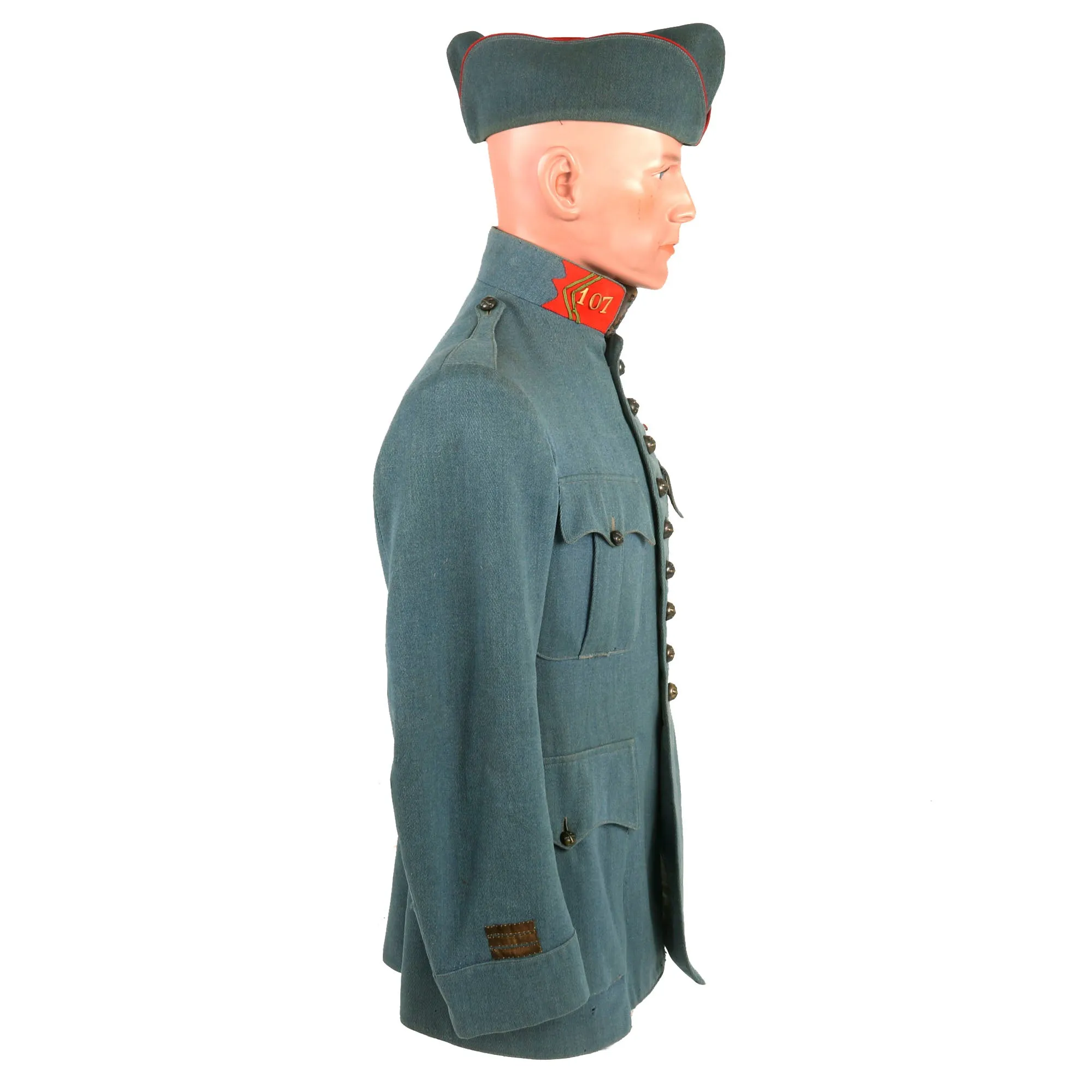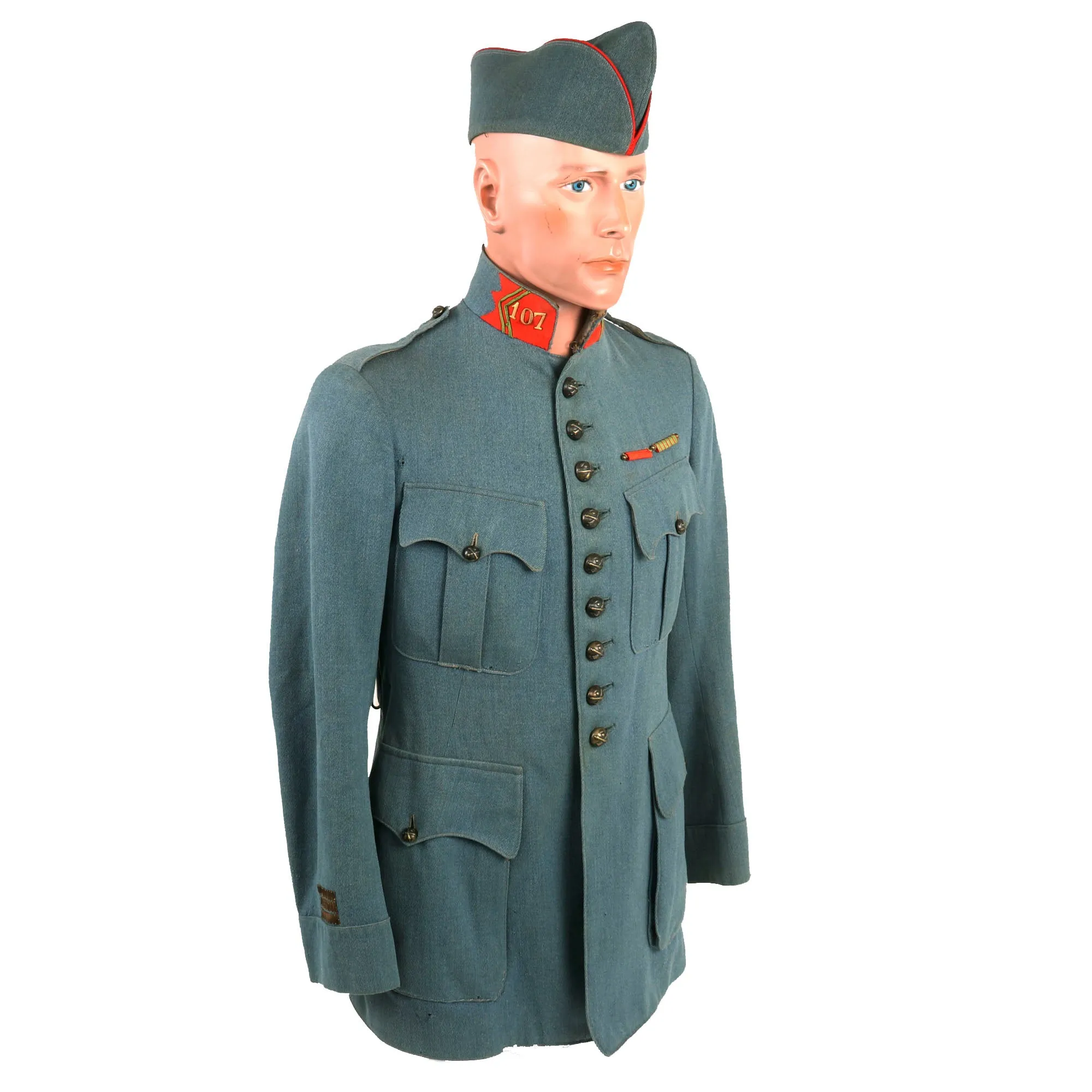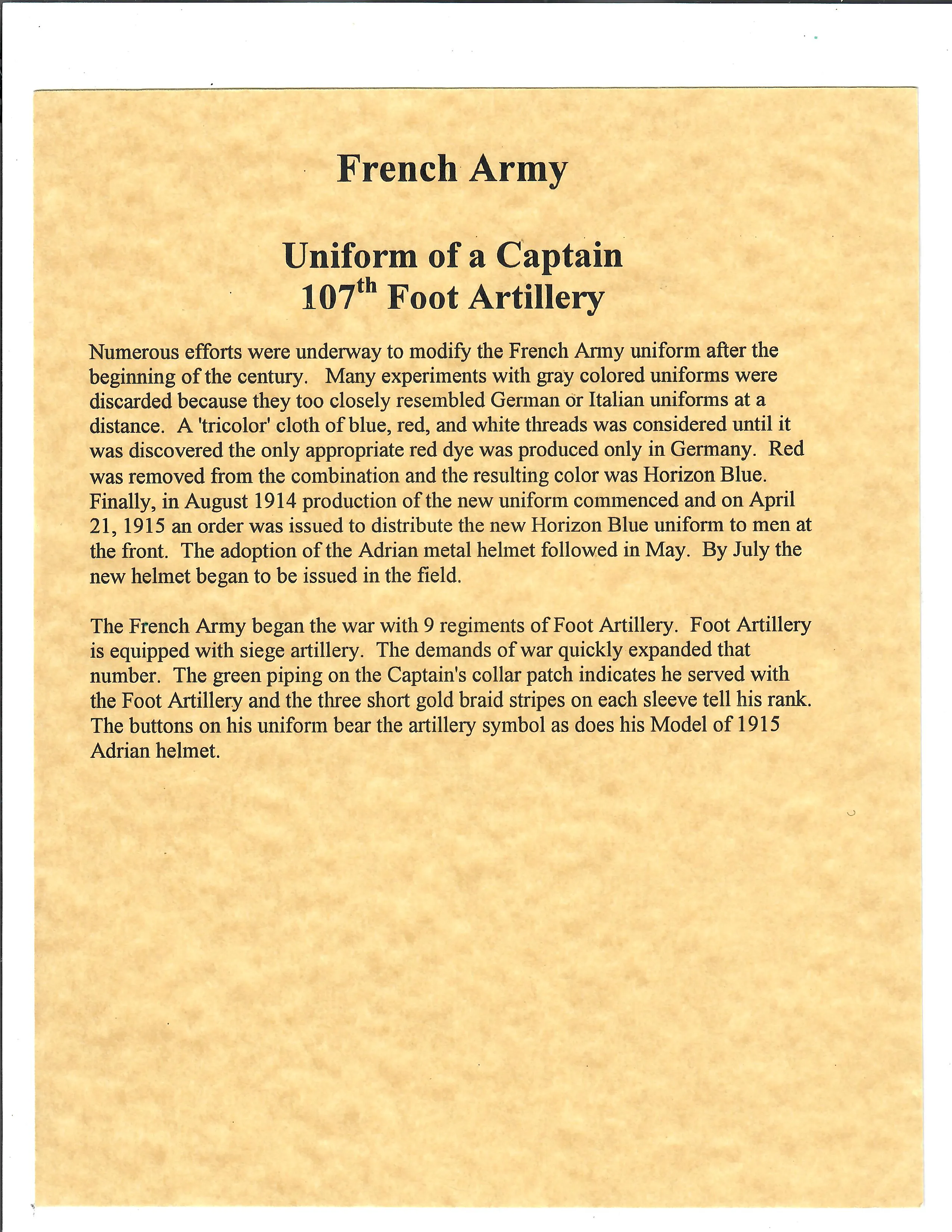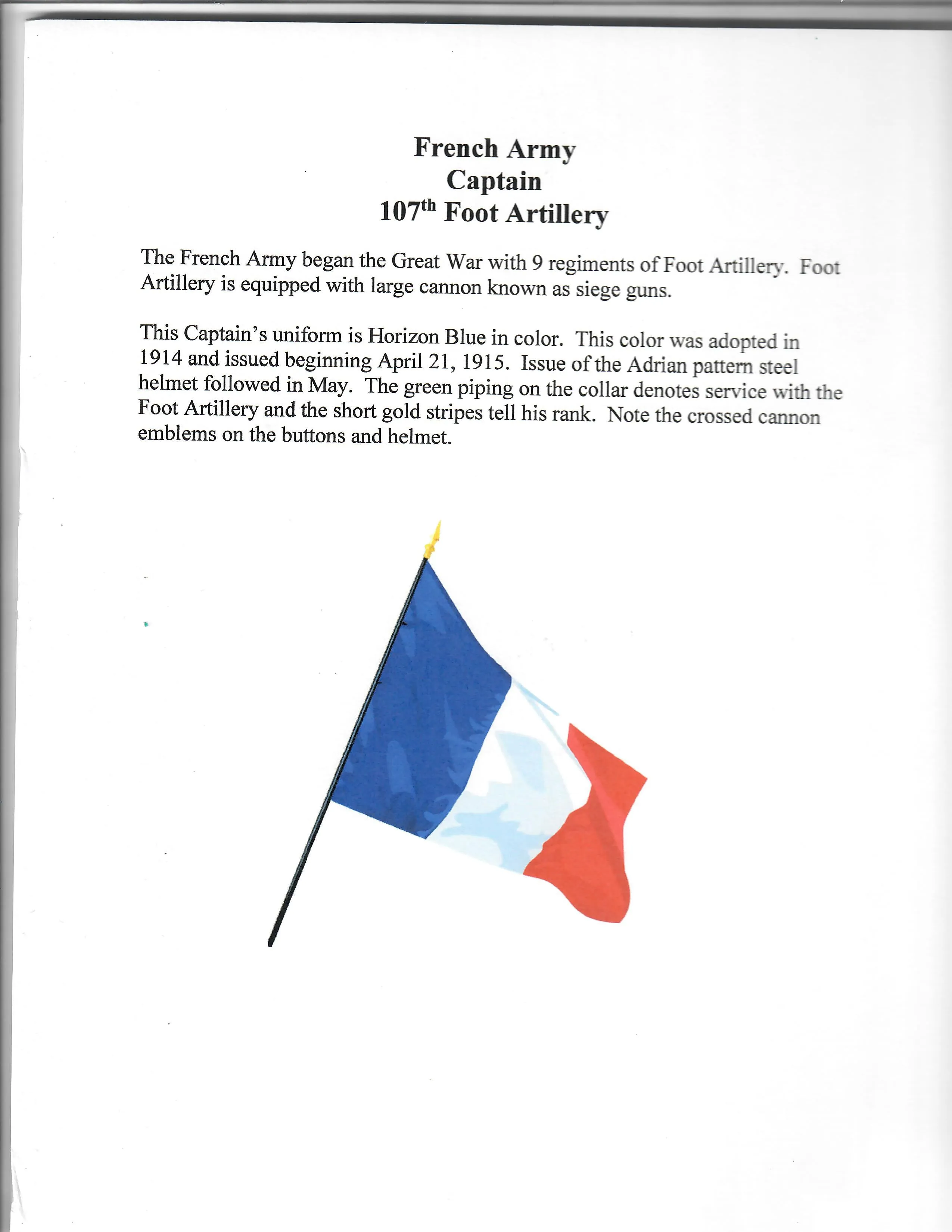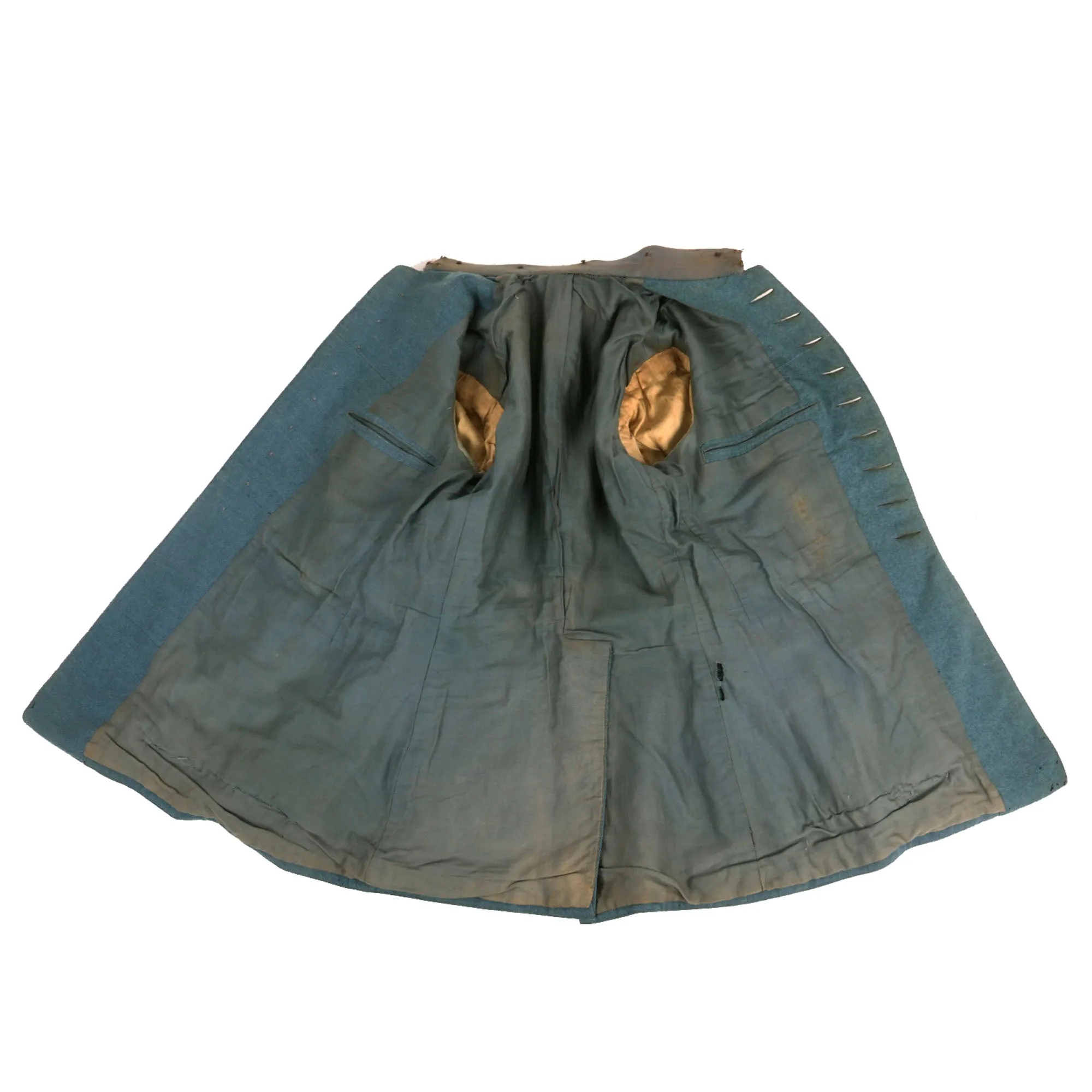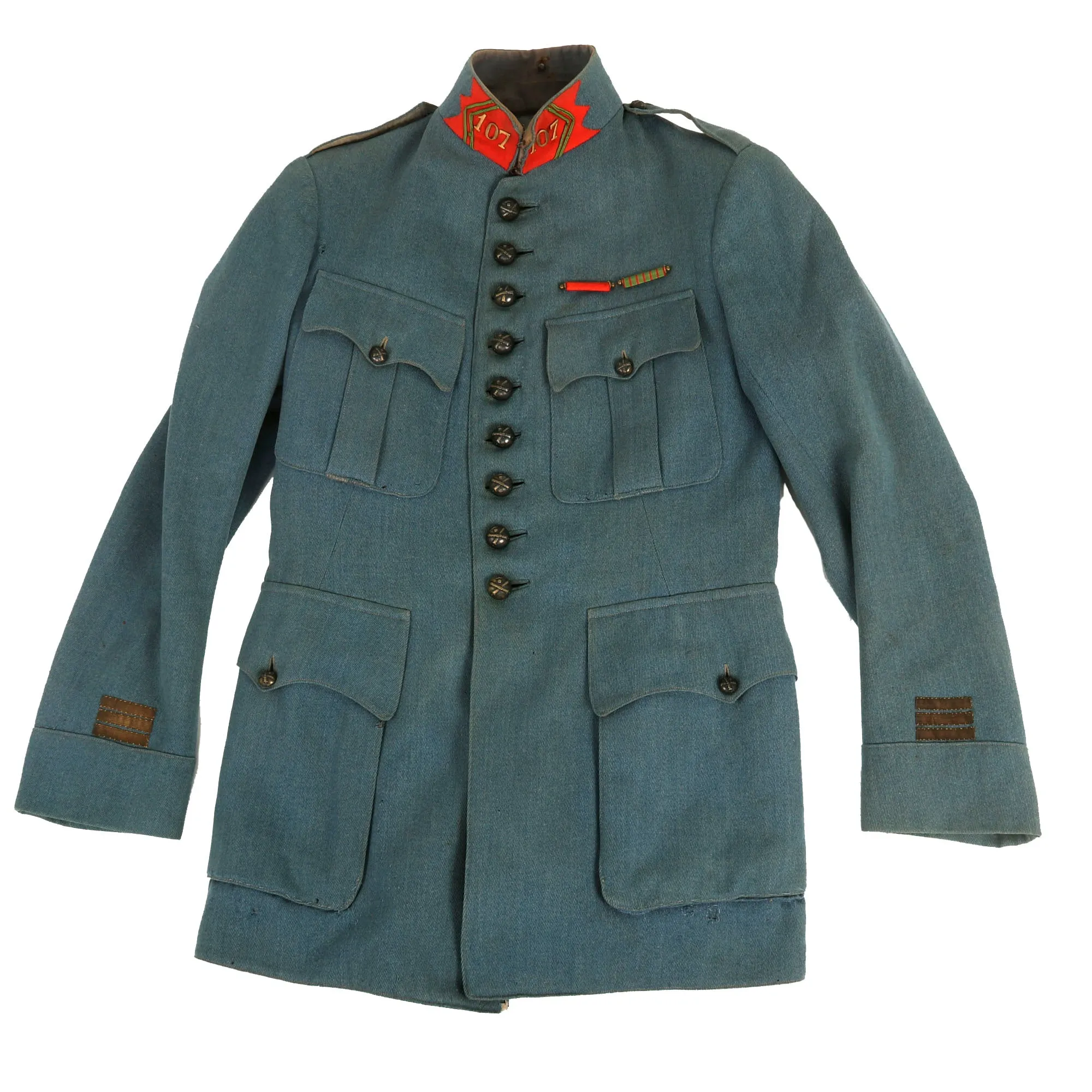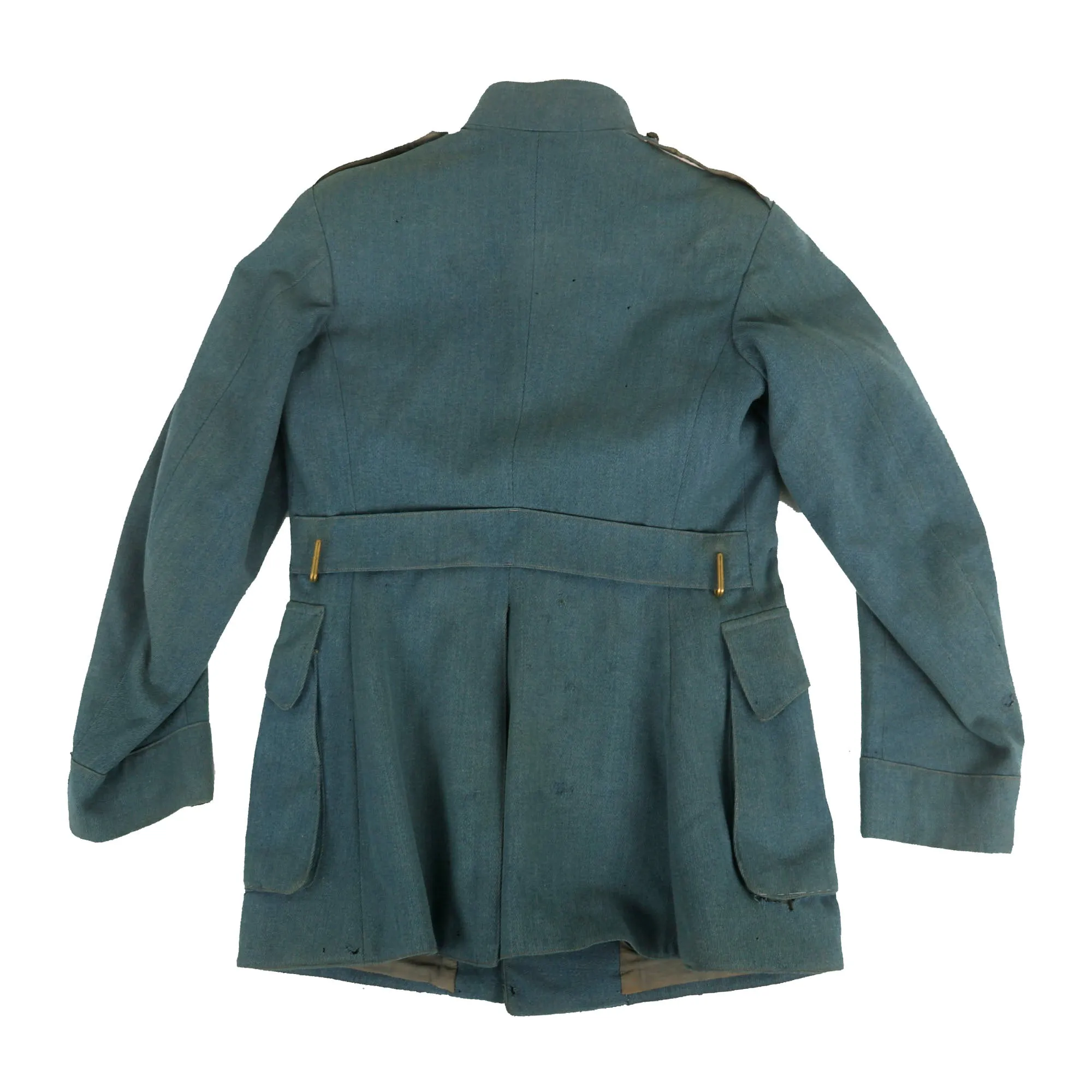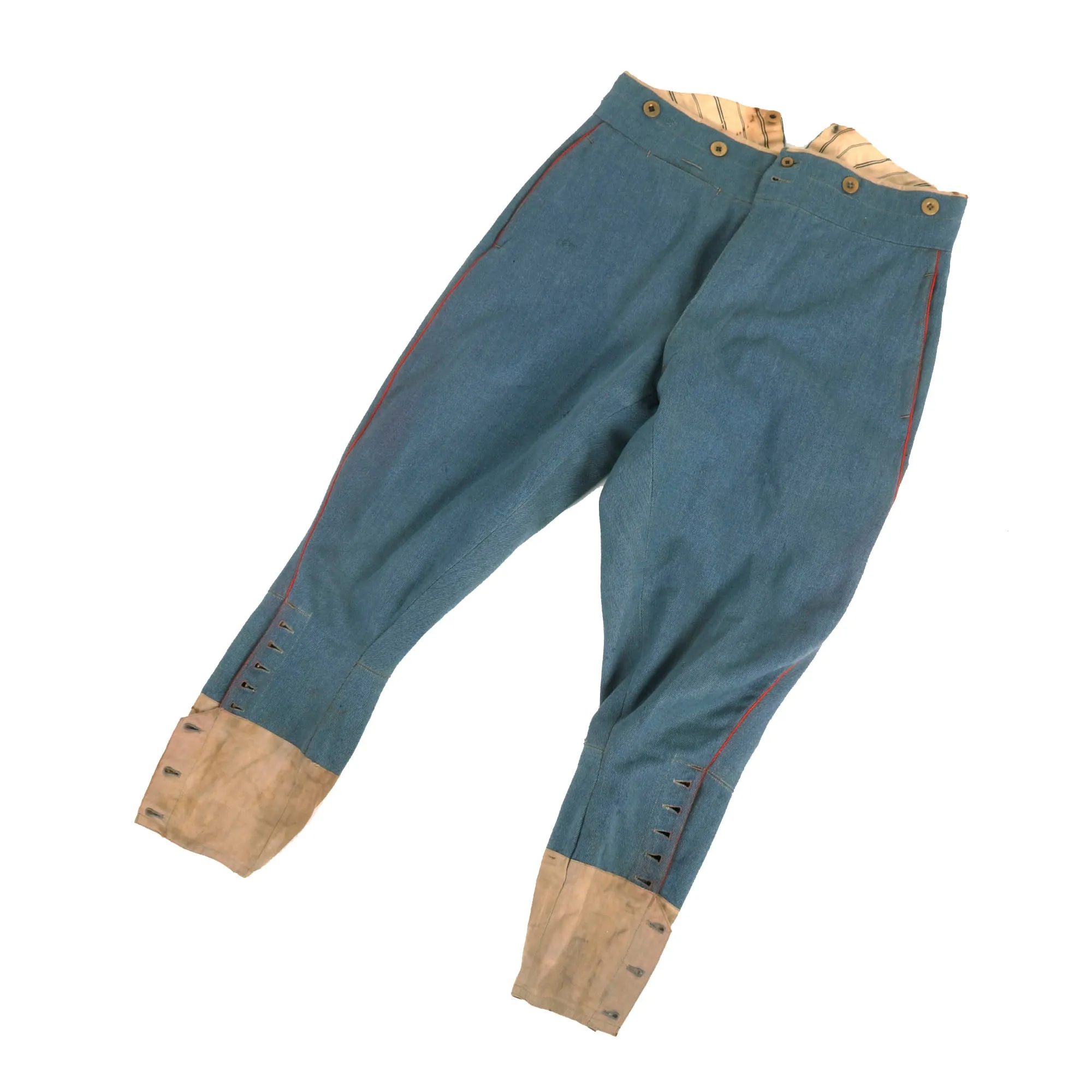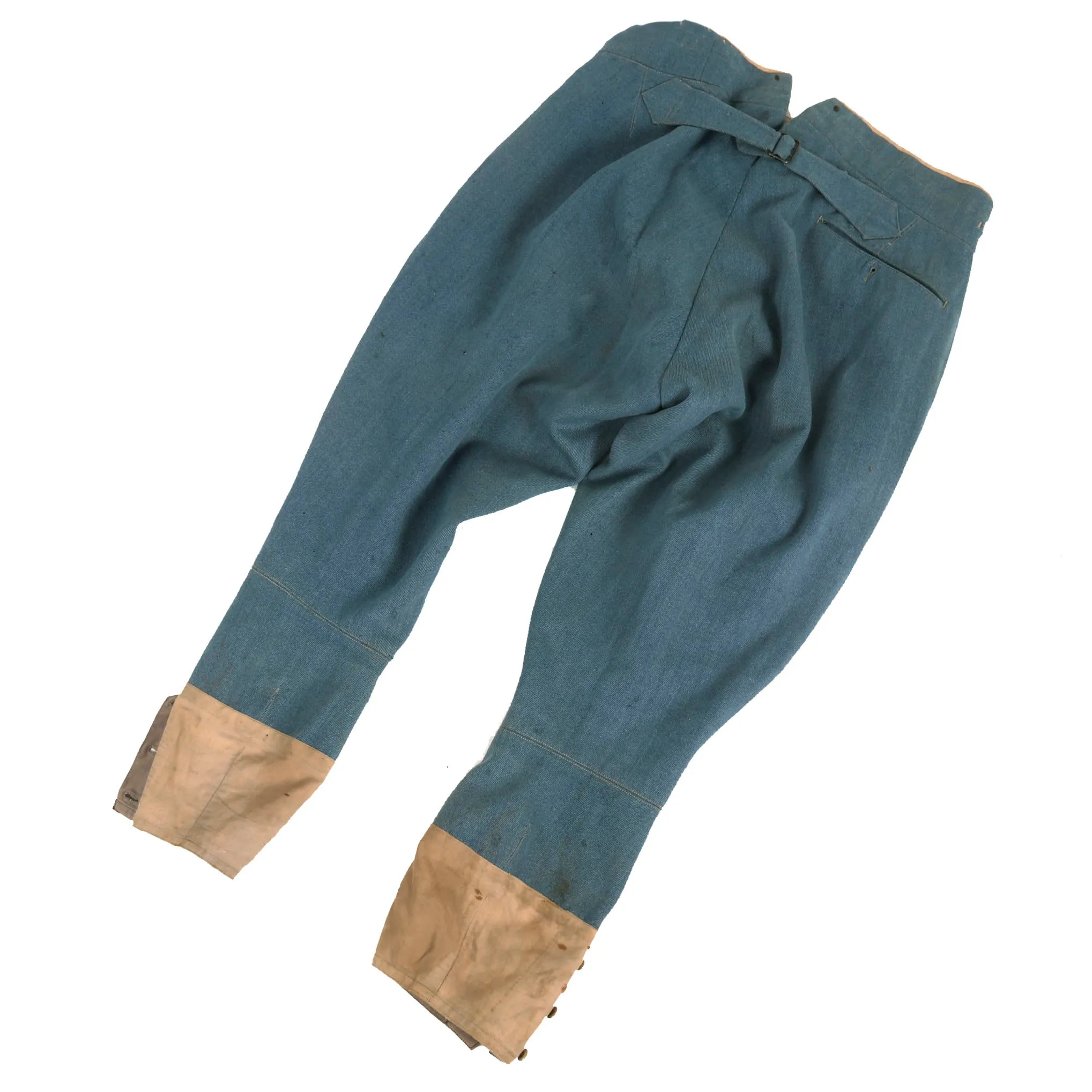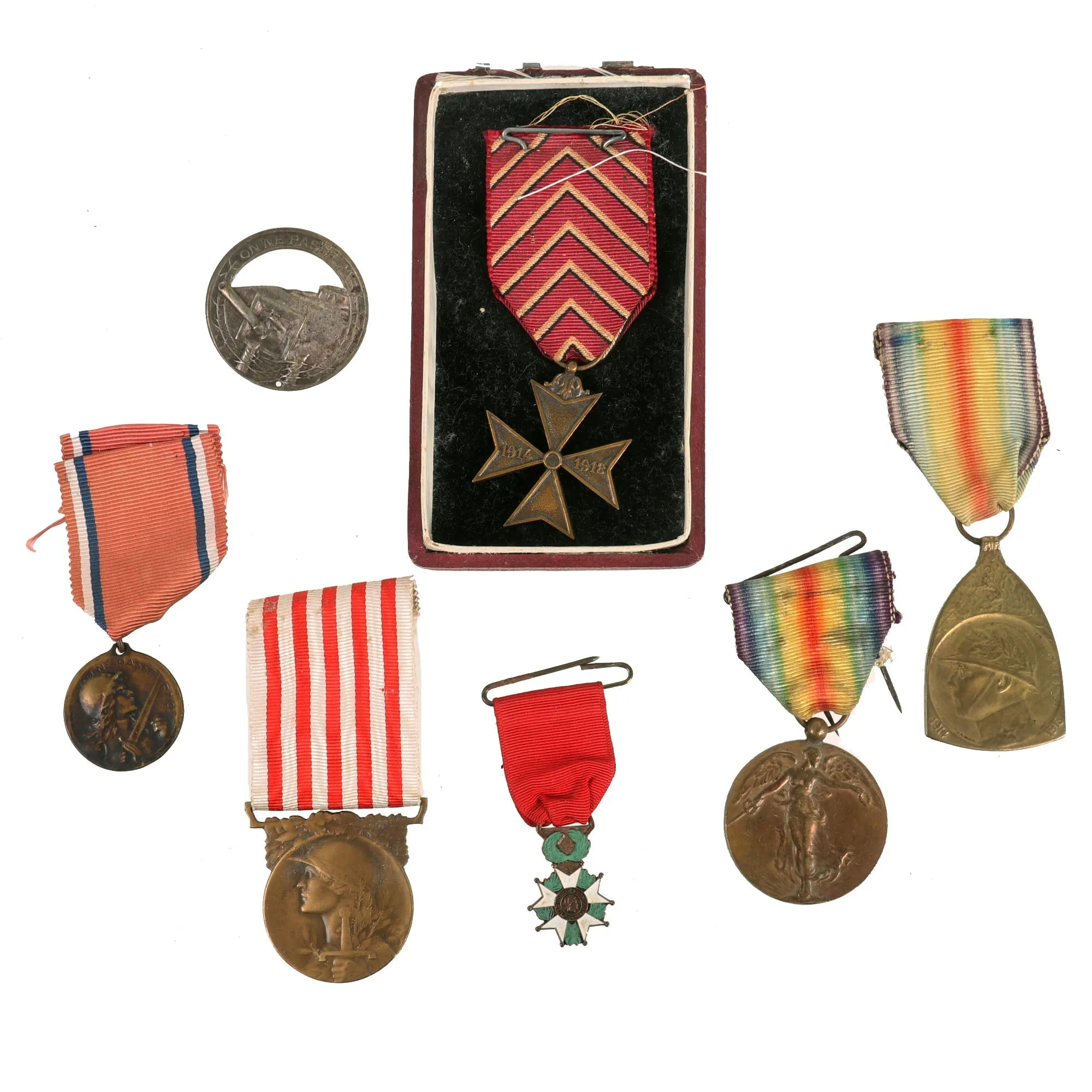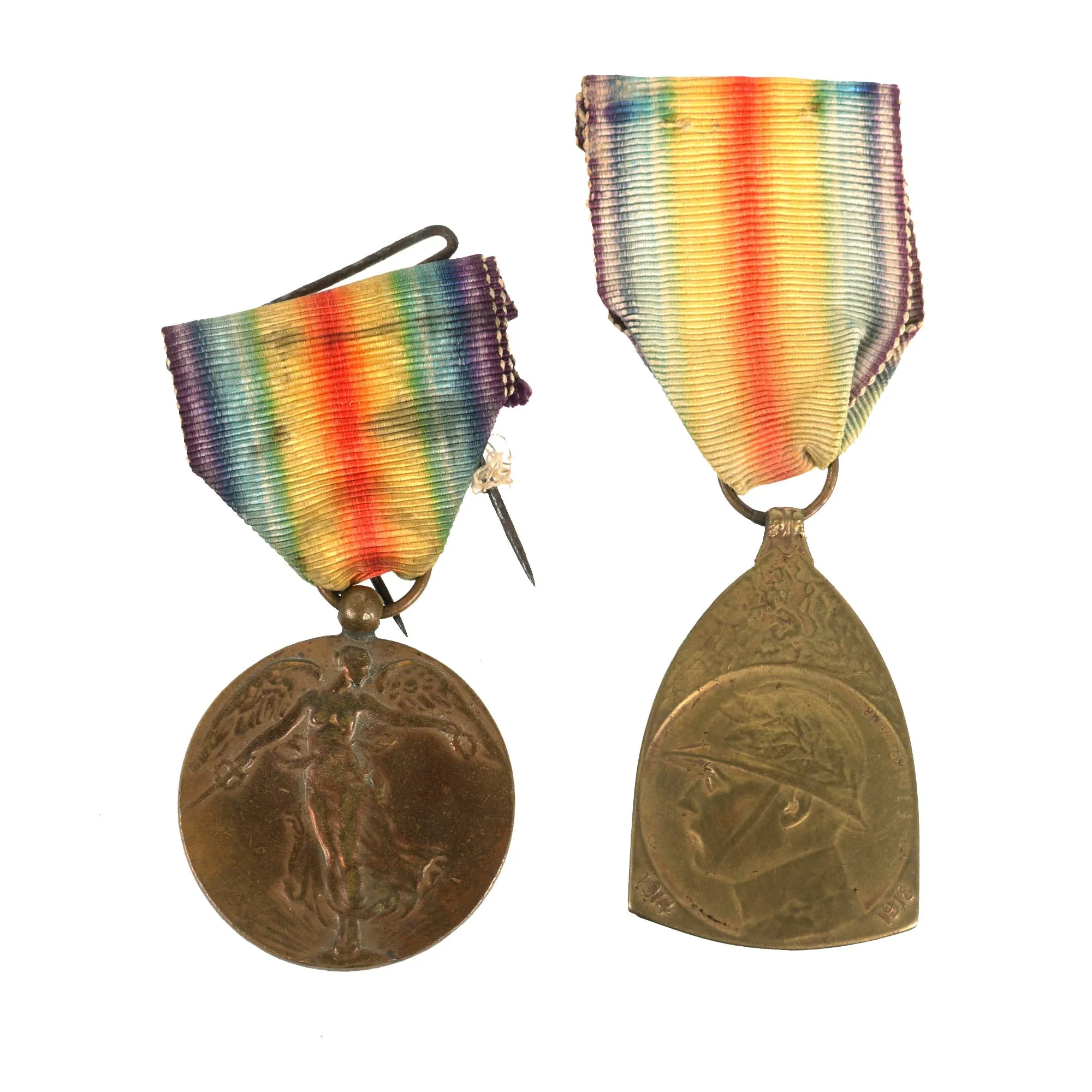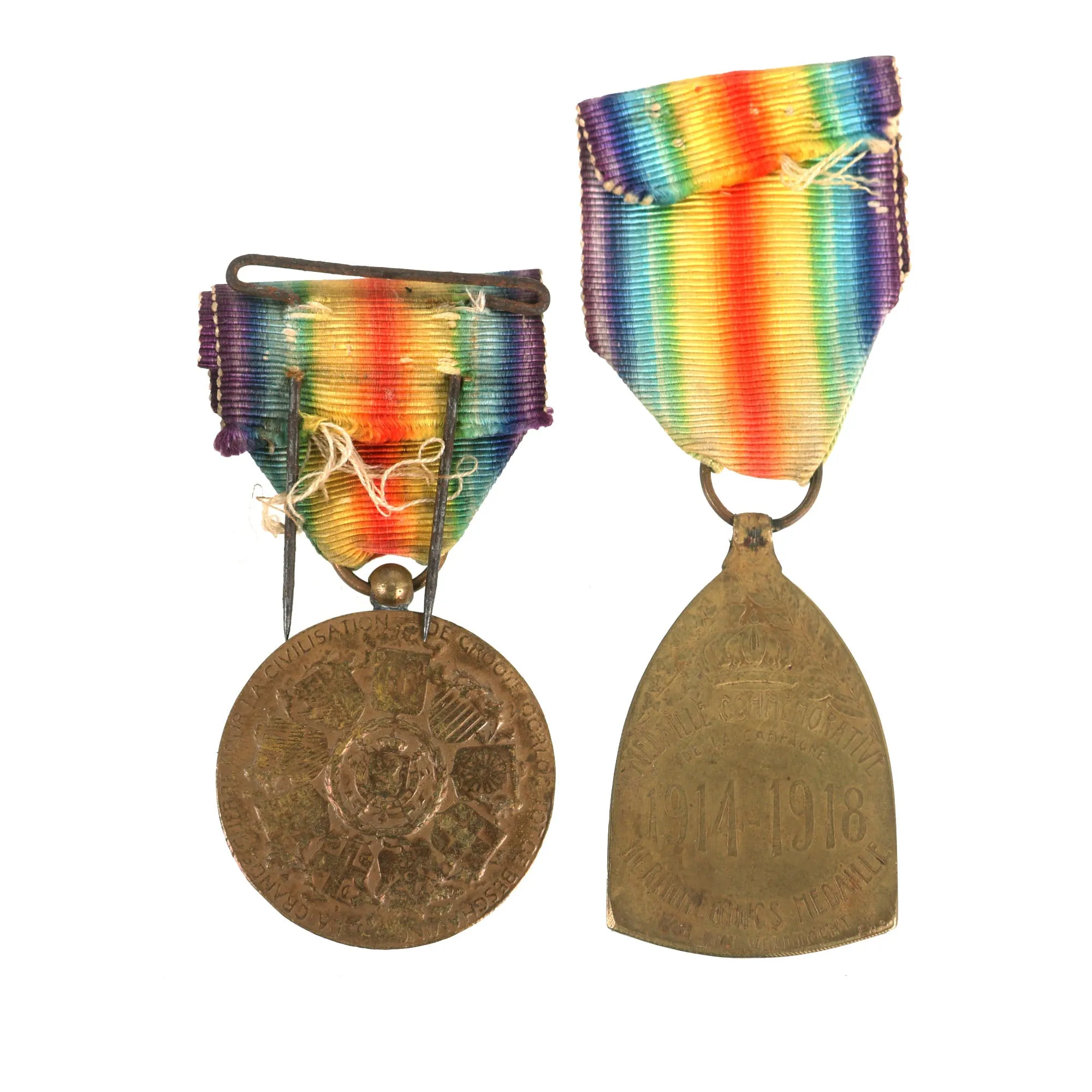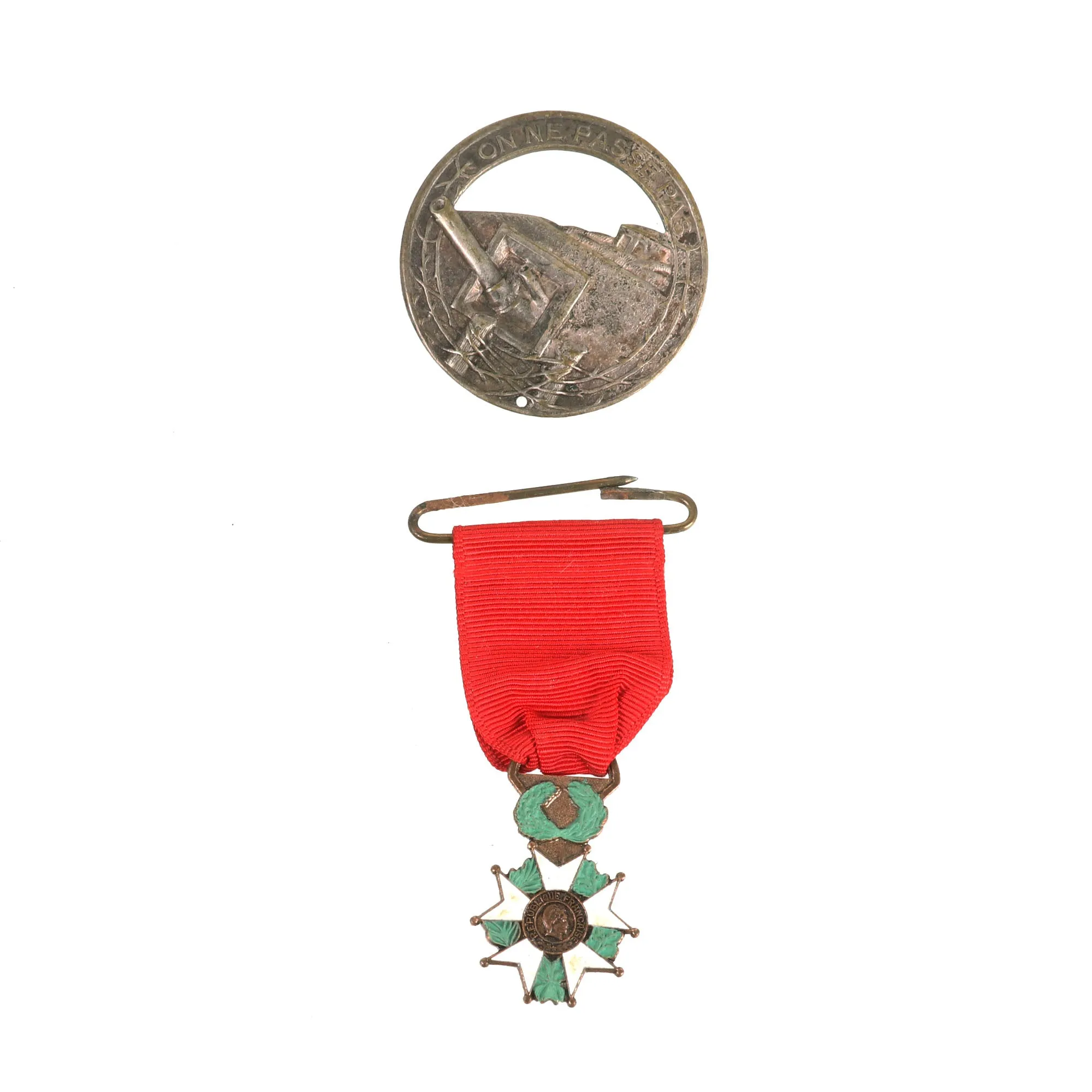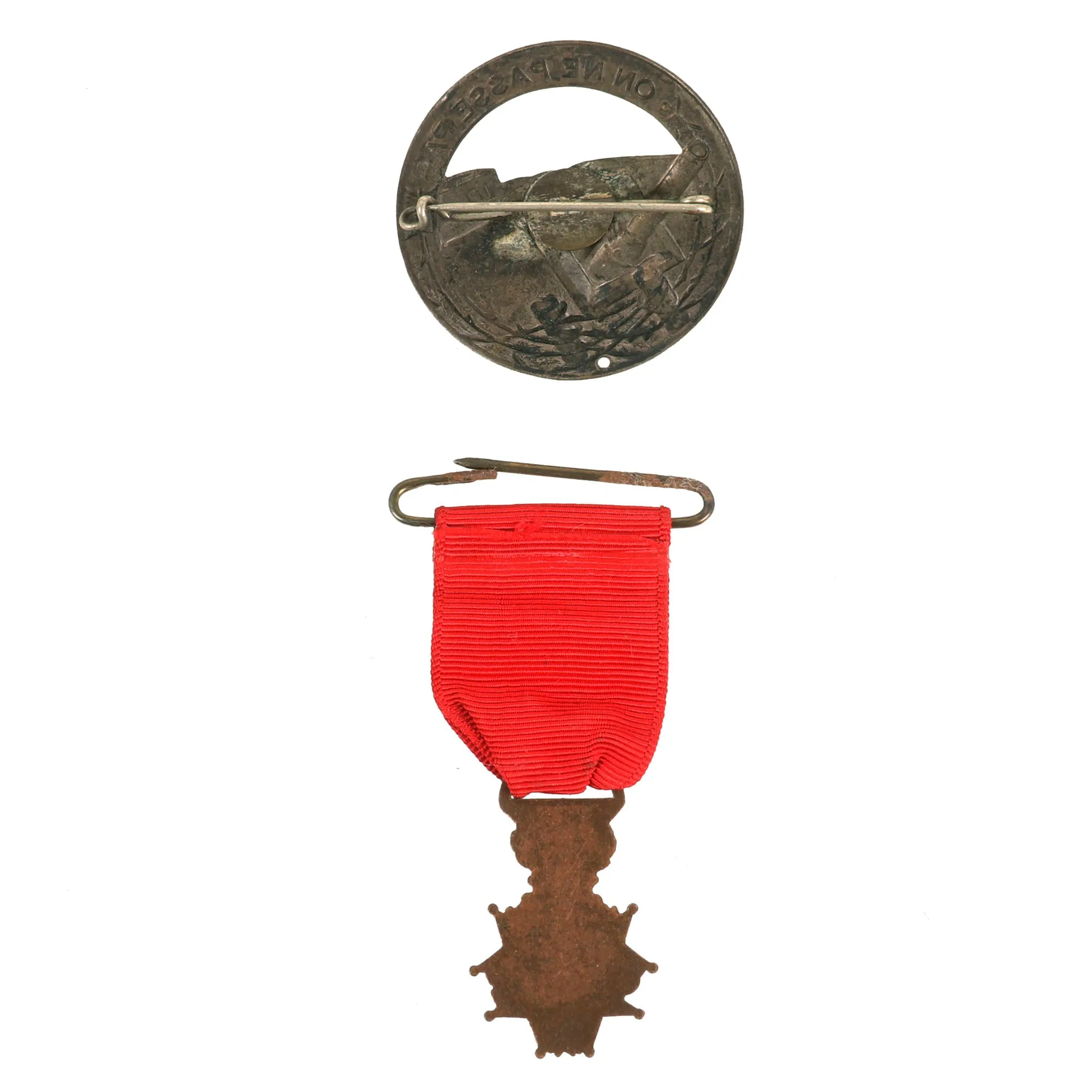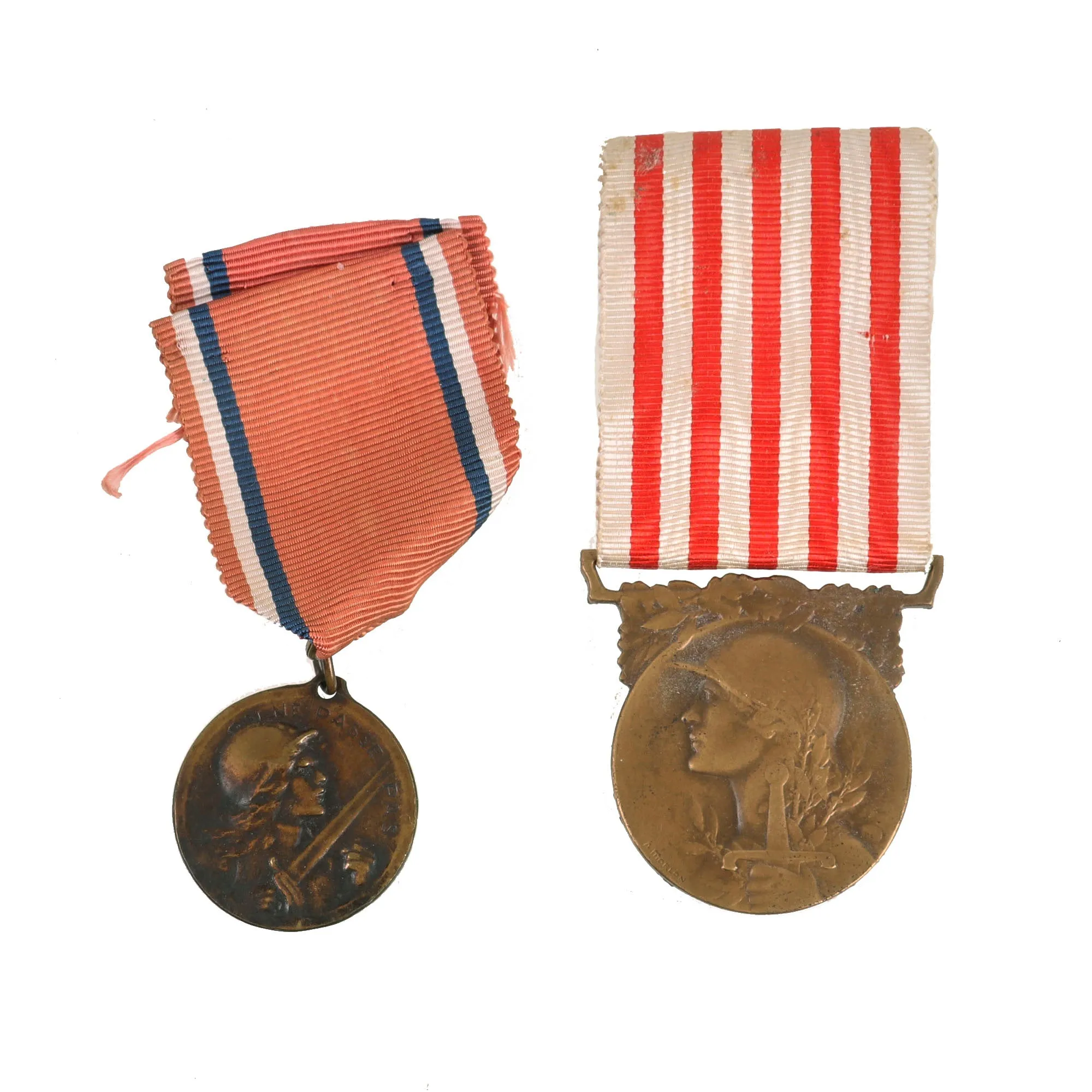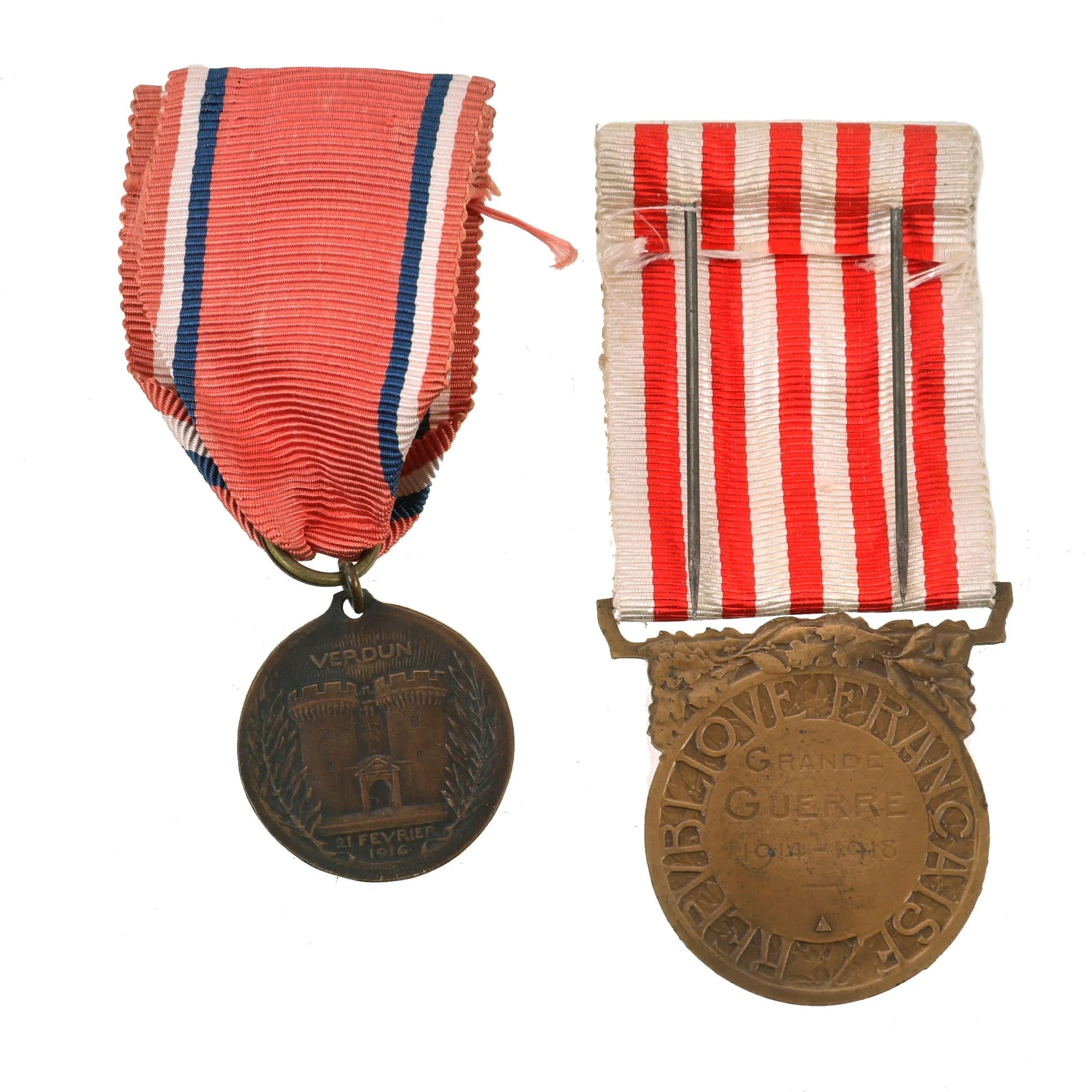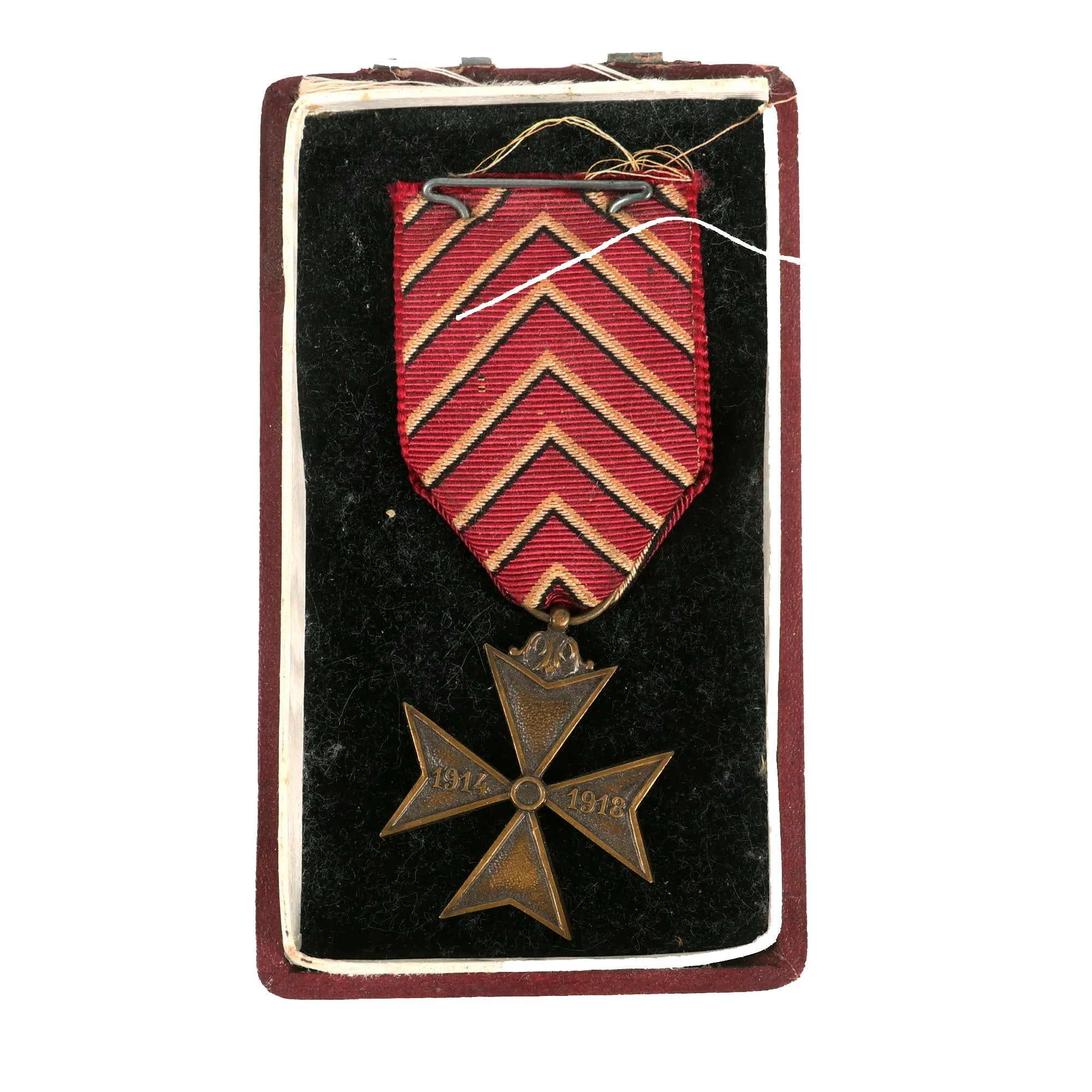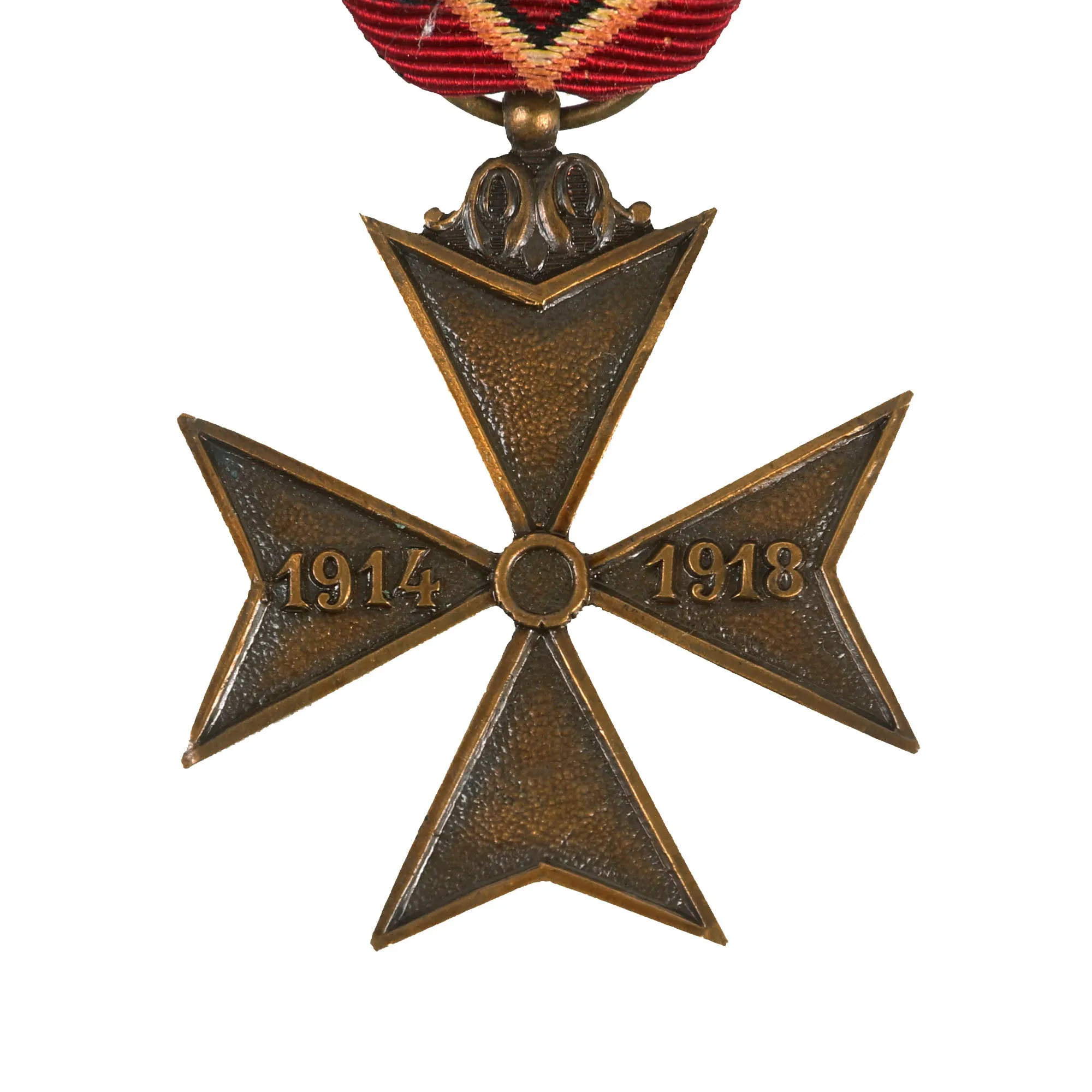Original Items: Only One Set Available. This heavy wool uniform set is in lovely, field used condition with various field repairs done to it as well as what appears to be possible post war repairs. The buttons still retain much of their original finish and all appear to be present. The tunic appears as “rough” but you have to keep in mind that the French, as well as the rest of the world, had fought a long and brutish war in their backyards. Resupplies were cut off, ambushes and attacks were always present and they were unable to acquire new items so the soldiers would have to repair and reuse what they already had, and this is a great example of that.
The trousers are in equally attractive condition though are a little bit more faded than the tunic which is not uncommon. The flat cap is faded but still retains a rough but complete leather sweatband.
Included with the uniform are the following medals:
- Battle of Verdun Medal: Created in late 1916 and even before the end of the battle, the Medal of Verdun was made for soldiers who, for several months under intense pressure from infantry attacks and heavy artillery pounding, held their ground during the WW1 Battle of Verdun.Around 70% of all the French soldiers that were engaged in World War I participated to the battle of Verdun. Six or seven different designs were put forward for the medal but none were approved by the French Government and all remained unofficial awards that could not be worn on military uniform. Originally intended to be “awarded to those who served on the Verdun front between 21 February 1916 and 2 November 1916, the medal was, in fact, awarded to those who served anywhere on the Argonne and St Mihiel sectors between 31 July 1914 and 11 November 1918.
The medal shows a red ribbon with a French flag supporting a bronze badge. The obverse shows the head of the Republic (a symbol of the IIIrd French Republic) and the famous sentence pronounced by Robert Nivelle: “Ils ne passeront pas”, translated as: they will not break through.
- 1914–1918 Commemorative war medal: The 1914–1918 Commemorative war medal (French: "Médaille commémorative de la guerre 1914–1918") was awarded to soldiers and sailors for service in World War I. It was also awarded to civilians who met certain requirements. Created by Act of June 23, 1920, it was awarded to any military member for service between 2 August 1914 and November 11, 1918. It is also given to civilians who served in the same period in the army or the Interior.
The medal is round with a diameter of 33 mm. It is bronze. On the obverse, is an effigy of a youthful Minerva in profile, wearing the helmet of 1915, representing France. She is crowned with laurels and holding a sword in her left hand. There are bay leaves mixed with oak leaves at the top to join a horizontal slit, through which the ribbon passes and is attached to the medal.
On the reverse is the legend: GRANDE GUERRE 1914-1918, surrounded by the inscription REPUBLIQUE FRANÇAISE.
The Belgian Inter-Allied Victory Medal 1914–1918 was a 36 mm in diameter circular gilt bronze medal. Its obverse bore a winged victory standing on a globe, her arms and wings spread out, looking down at Earth. The reverse bore, superimposed over a laurel wreath, the coats of arms of the Allies, starting at center top and going clockwise, French Third Republic, United States, Empire of Japan, Kingdom of Greece, Brazil, Serbia, Portugal, Kingdom of Italy, United Kingdom, and at center, the Royal Coat of Arms of Belgium. Along the outer circumference, the relief bilingual inscription in French and Dutch "THE GREAT WAR FOR CIVILISATION" (French: LA GRANDE GUERRE POUR LA CIVILISATION", Dutch: "DE GROOTE OORLOG TOT DE BESCHAVING").
- Commemorative Medal of the 1914–1918 War With Victory Medal Ribbon: The Commemorative Medal of the 1914–1918 War was a Belgian commemorative war medal established by royal decree on 21 July 1919 and awarded to all members of the Belgian Armed Forces who served during the First World War that were eligible for the inter-allied victory medal.
The Belgian 1914–1918 Commemorative War Medal was struck from bronze, it was 47 mm high by 31 mm wide, triangular shaped and with rounded sides. On its obverse, the relief left profile of a helmeted soldier within a 29 mm in diameter circular recess, the helmet adorned with laurels. Between the circular recess and the bottom left corner of the medal, the relief date "1914", in the lower right corner, the relief date "1918". In the upper point of the triangle, above the circular recess, the relief images of a lion rampant with an oak branch to its left and a laurel branch to its right. On the reverse, near the top, the relief image of a crown surrounded by the same branches as the lion on the obverse, below the crown, the relief semi circular inscription in French on two rows over the large relief dates "1914 – 1918", "MEDAILLE COMMEMORATIVE / DE LA CAMPAGNE", the inscription repeated in Dutch below the dates "HERDENKINGSMEDAILLE / VAN DEN VELDTOCHT" (COMMEMORATIVE MEDAL OF THE 1914 – 1918 CAMPAIGN).
- Belgian Victory Medal 1914–1918: The Victory Medal is the Belgian variant of the Inter-Allied Victory Medal 1914–1918 was a Belgian commemorative war medal established by royal decree on 15 July 1919 and awarded to all members of the Belgian Armed Forces who served during the First World War. Later royal decrees enlarged the list of potential recipients to include service in African campaigns and under special circumstances, to members of the merchant navy and fishing fleet. In all, 350,000 were awarded.
- Miniature Legion of Honor for Knight (Chevalier): The National Order of the Legion of Honour, formerly the Royal Order of the Legion of Honour, is the highest French order of merit, both military and civil. Established in 1802 by Napoleon Bonaparte, it has been retained (with occasional slight alterations) by all later French governments and regimes.
- Maginot Line French Brooch Pin Badge: The motto "On ne passe pass" (They shall not pass) was most famously used during the Battle of Verdun in World War I by French General Robert Nivelle. It appeared on propaganda posters, such as that by Maurice Neumont after the Second Battle of the Marne, which was later adopted on uniform badges by units manning the Maginot Line.
- Belgian Deportees' Cross 1914–1918 With Repaired Case: The Deportees' Cross 1914–1918 was a Belgian war medal established on 27 November 1922 by royal decree and awarded to Belgian citizens deported to Germany for forced labor during the First World War. Deportees who died during their deportation were not awarded this cross, instead, they received the Order of Leopold II with the ribbon bearing a central longitudinal gold stripe.
The Deportees' Cross 1914–1918 is a 38mm wide bronze cross pattée with identical obverse and reverse. The horizontal arms bear the relief inscription "1914" on the right arm and "1918" on the left arm.
The cross is suspended by a ring through a suspension loop from a 37mm wide dark red silk moiré ribbon adorned with 3mm chevrons in the national colors of Belgium.
A lovely uniform set that comes more than ready for further research and display.
Approximate Measurements:
Collar to shoulder: 9"
Shoulder to sleeve: 25”
Shoulder to shoulder: 14.5”
Chest width: 17.5"
Waist width: 16.5"
Hip width: 22"
Front length: 33"
Pants:
Waist: 16"
Inseam: 24"
At the outbreak of war the French Army retained the colorful traditional uniforms of the nineteenth century for active service wear. These included conspicuous features such as blue coats and red trousers for the infantry and cavalry. The French cuirassiers wore plumed helmets and breastplates almost unchanged from the Napoleonic period. From 1903 on several attempts had been made to introduce a more practical field dress but these had been opposed by conservative opinion both within the army and amongst the public at large. In particular, the red trousers worn by the infantry became a political debating point. Adolphe Messimy who was briefly Minister of War in 1911-1912 stated that "This stupid blind attachment to the most visible of colours will have cruel consequences"; however, in the following year, one of his successors, Eugène Étienne, declared "Abolish red trousers? Never!"
In order to appease traditionalists, a new cloth was devised woven from red, white and blue threads, known as "Tricolor cloth", resulting in a drab purple-brown color. Unfortunately the red thread could only be produced with a dye made in Germany, so only the blue and white threads were used. The adoption of the blue-gray uniform known as "horizon-blue" because it was thought to prevent soldiers from standing out against the skyline, had been approved by the French Chamber of Deputies on 10 July 1914 but was not issued until later on.
Horizon blue is a color name which is well remembered because it was used for the blue-gray uniforms of French metropolitan troops from 1915 through 1921.
This name for a shade of blue which refers to the indefinable color which separates the sky from the earth, had been previously used in the world of fashion, and has been since then. It had also served as an emblem of political groups prevailing upon the army of the Great War.
French Army in World War I
During World War I, France was one of the Triple Entente powers allied against the Central Powers. Although fighting occurred worldwide, the bulk of the conflict in Europe occurred in Belgium, Luxembourg, France and Alsace-Lorraine along what came to be known as the Western Front, which consisted mainly of trench warfare. Specific operational, tactical, and strategic decisions by the high command on both sides of the conflict led to shifts in organizational capacity, as the French Army tried to respond to day-to-day fighting and long-term strategic and operational agendas. In particular, many problems caused the French high command to re-evaluate standard procedures, revise its command structures, re-equip the army, and to develop different tactical approaches.
France had been the major power in Europe for most of the Early Modern Era: Louis XIV, in the seventeenth century, and Napoleon I in the nineteenth, had extended French power over most of Europe through skillful diplomacy and military prowess. The Treaty of Vienna in 1815 confirmed France as a European power broker. By the early 1850s, Prussian Chancellor Otto von Bismarck started a system of alliances designed to assert Prussian dominance over Central Europe. Bismarck's diplomatic maneuvering, and France's maladroit response to such crises as the Ems Dispatch and the Hohenzollern Candidature led to the French declaration of war in 1870. France's subsequent defeat in the Franco-Prussian War, including the loss of its army and the capture of its emperor at Sedan, the loss of territory, including Alsace-Lorraine, and the payment of heavy indemnities, left the French seething and placed the reacquisition of lost territory as a primary goal at the end of the 19th century; the defeat also ended French preeminence in Europe. Following German Unification, Bismarck attempted to isolate France diplomatically by befriending Austria-Hungary, Russia, Britain, and Italy.
After 1870, the European powers began gaining settlements in Africa, with colonialism on that continent hitting its peak between 1895 and 1905. However, colonial disputes were only a minor cause of World War I, as most had been settled by 1914. Economic rivalry was not only a source for some of the colonial conflicts but also a minor cause for the start of World War I. For France, the rivalry was mostly with the rapidly industrializing Germany, which had seized the coal-rich region of Alsace-Lorraine in 1870, and later struggled with France over mineral-rich Morocco.
Another cause of World War I was growing militarism which led to an arms race between the powers. As a result of the arms race, all European powers were ready for war and had time tables that would send millions of reserves into combat in a matter of days.
France was bound by treaty to defend Russia. Austria-Hungary had declared war on Serbia due to the Black Hand's assassination of Archduke Ferdinand, which acted as the immediate cause of the war. France was brought into the war by a German declaration of war on August 3, 1914.




